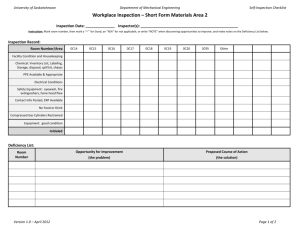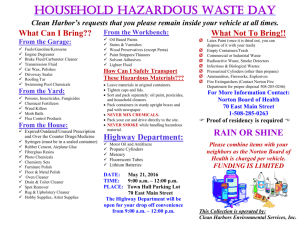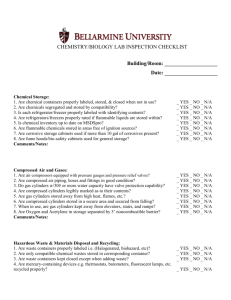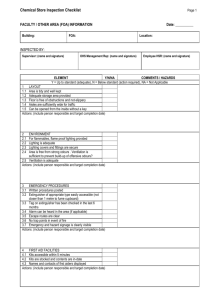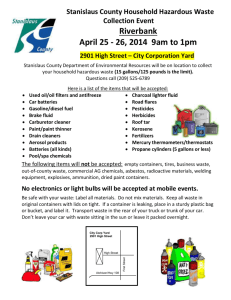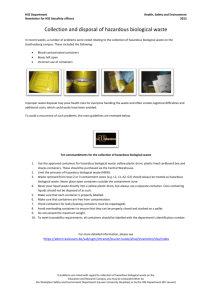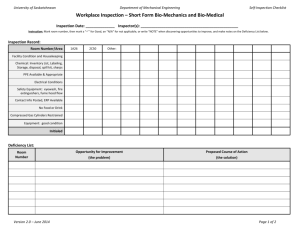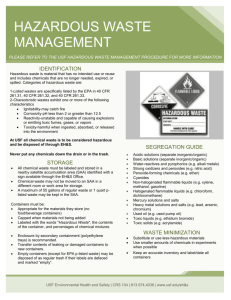General Laboratory Checklist
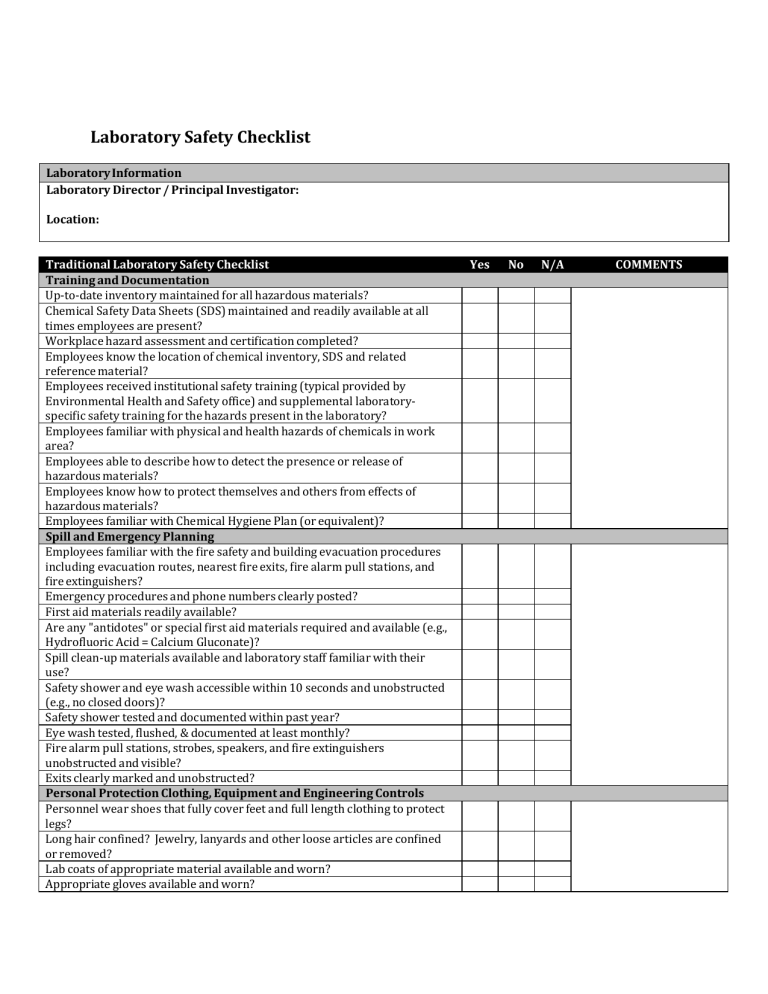
Laboratory Safety Checklist
Laboratory Information
Laboratory Director / Principal Investigator:
Location:
Traditional Laboratory Safety Checklist
Training and Documentation
Up-to-date inventory maintained for all hazardous materials?
Chemical Safety Data Sheets (SDS) maintained and readily available at all times employees are present?
Workplace hazard assessment and certification completed?
Employees know the location of chemical inventory, SDS and related reference material?
Employees received institutional safety training (typical provided by
Environmental Health and Safety office) and supplemental laboratory- specific safety training for the hazards present in the laboratory?
Employees familiar with physical and health hazards of chemicals in work area?
Employees able to describe how to detect the presence or release of hazardous materials?
Employees know how to protect themselves and others from effects of hazardous materials?
Employees familiar with Chemical Hygiene Plan (or equivalent)?
Spill and Emergency Planning
Employees familiar with the fire safety and building evacuation procedures including evacuation routes, nearest fire exits, fire alarm pull stations, and fire extinguishers?
Emergency procedures and phone numbers clearly posted?
First aid materials readily available?
Are any "antidotes" or special first aid materials required and available (e.g.,
Hydrofluoric Acid = Calcium Gluconate)?
Spill clean-up materials available and laboratory staff familiar with their use?
Safety shower and eye wash accessible within 10 seconds and unobstructed
(e.g., no closed doors)?
Safety shower tested and documented within past year?
Eye wash tested, flushed, & documented at least monthly?
Fire alarm pull stations, strobes, speakers, and fire extinguishers unobstructed and visible?
Exits clearly marked and unobstructed?
Personal Protection Clothing, Equipment and Engineering Controls
Personnel wear shoes that fully cover feet and full length clothing to protect legs?
Long hair confined? Jewelry, lanyards and other loose articles are confined or removed?
Lab coats of appropriate material available and worn?
Appropriate gloves available and worn?
Yes No N/A COMMENTS
Traditional Laboratory Safety Checklist
Goggles, face shields, are of appropriate type and worn?
Respirators available and used in the laboratory? If yes…
Respirator training, fit test and medical evaluation completed for employees?
Respirators cleaned, stored, and inspected regularly?
Chemical hood available? If yes…
Chemical hood free of clutter?
Chemical hood inspected within last 12 months and capable of drawing at least 100 LFPM (or more if appropriate)?
Chemical hoods equipped with air flow indicator?
Perchloric acid operations conducted in specialized wash-down chemical hoods?
Biological Safety Cabinet available? If yes…
Biological Safety Cabinet free of clutter and surfaces decontaminated?
Biological Safety Cabinet certified within last 12 months?
Mechanical pipetting used, no mouth suction?
Chemical Safety
Are chemicals used in this area? If yes…
Appropriate labels are found on all hazardous chemical containers?
Containers are in good condition (e.g., labels intact, metal cans free of rust) and closed when not in use?
Containers properly segregated by hazard class (e.g., flammables away from oxidizers, acids separate from bases, incompatible acids separated)?
Storage of chemicals above eye level is avoided?
Flammable liquids stored in OSHA/NFPA approved cabinets and safety containers?
Flammables liquids requiring refrigeration stored in either explosion- proof or flammable resistant refrigerators and freezers (i.e., no regular refrigerators)?
Ignition sources avoided when using/storing flammables?
Corrosives stored in acid cabinets or other appropriate cabinets?
Peroxide formers properly labeled and inventory tracked?
Picric acid sufficiently wet?
Large containers (4L or greater) stored near the floor?
Bottle carriers or carts utilized when transporting hazardous chemicals between work areas?
Proper signs delineate designated areas where high hazard chemicals are used?
Designated area properly cleaned and decontaminated?
Biological Safety
Are biological materials used in this area? If yes…
Biological materials are not stored in hallways in unlocked freezers or refrigerators.
Biohazard signs are posted in labs handling infectious materials (BSL2 and higher).
Disinfectants are on hand for sanitizing bench tops and treating spills.
Biological safety cabinet(s) was certified within the last 12 months.
Ionizing and Non-Ionizing Radiation Safety
Are radioactive materials used in this area? If yes…
Pure beta emitters (e.g., P-32, P-33, S-35, C-14)?
Gamma and x-ray emitters (e.g., I-125, I-131, Cr-51, Na-22)?
Yes No N/A COMMENTS
Traditional Laboratory Safety Checklist
Volatile, gaseous radioisotopes (e.g., I125) or aerosol/dust generating laboratory operations (e.g., vacuum flasks)?
Sealed sources?
Irradiators?
X-ray generating equipment (Electron
Microscope
, X-ray diffraction,
Diagnostic X-ray, Computed Tomography)?
Is the proper shielding available for the types of radioisotopes being used?
Are appropriate meters available for radioactive material used and are meter(s) calibrated?
Are radiation workers provided personal monitoring when required?
Are all appropriate signs posted? (Radiation Labels, Notice to
Employees and Emergency Procedures)
Are all spaces and items which store, handle or use radioactive materials properly labeled with “Radioactive Material”, “Radiation Area” or other applicable hazard warning labels?
Are radioactive materials secured/locked against unauthorized access from non-authorized users?
Is non-ionizing radiation used in the area? If yes…
Laser – Class 1?
Laser – Class 2?
Laser – Class 3a?
Laser – Class 3b?
Laser – Class 4?
Personal protective equipment (e.g., eye protection) or shielding available specific to the Class lasers used?
Laser hazard warning signage posted?
(Laser, Electromagnetic)
Compressed and Cryogenic Gas Safety
Are compressed gas cylinders used in this area? If yes…
Cylinders stored upright and properly secured at all times?
Caps properly secured when cylinders are not in use?
Regulators always used, proper regulators used for type gas, pressure bled when not in use?
Cylinders in good condition and clearly marked?
Flammables stored separately from oxidizers, toxics in secure area, etc.?
Cylinders of flammable gases stored in ventilated enclosures?
Cylinders moved on cylinder trucks with regulators removed and caps secured?
Cylinders of toxic gases (e.g., NFPA health hazard 3 or 4 and 2) stored and used in continuously ventilated enclosures?
Cryogenic gas cylinder pressure relief values in proper working condition?
Oxygen monitor available in areas with increased likelihood of oxygen deficient atmospheres?
Equipment and Physical Hazards Safety
Are equipment safety signs posted and in good condition?
Are all guards and shields in place and secured?
Are safe work practices (long hair tied back, no loose clothing, etc.) being adhered to by all equipment users?
Is equipment in good repair with evidence of proper maintenance?
Yes No N/A COMMENTS
Traditional Laboratory Safety Checklist
Are electrical cords in good condition, out of travel paths, and free of any cracks or breaks in insulation?
Is proper PPE available and being used by equipment operators?
Is a tagging system in place to prevent use of damaged equipment?
Is access to the equipment restricted?
Have all users been trained to operate this equipment?
Are any additional or new hazards present at or around the equipment?
Have there been any modifications to the equipment?
General Laboratory Safety
Smoking, eating, and drinking prohibited in lab?
Lab is maintained secure; door is locked when no one is in lab?
Appropriate warning signs posted near lab entrance?
Unobstructed aisles maintained at least 36 in. wide throughout?
Lab benches and work areas free of clutter?
Shelves and cabinets in good condition?
Shelves have seismic restraints, e.g., lips or wires?
Shelves and cabinets secured to walls?
Storage above eye level minimized and items restrained from falling?
Refrigerators and freezers clearly labeled "Not for Storage of Food for
Human Consumption"?
No storage of food or drink in refrigerators, unless dedicated for such and clearly labeled?
Waste Management
Wastes are not discarded via trash or drain disposal unless specifically approved by the appropriate institutional authority (e.g., Environmental
Health and Safety)?
Is hazardous chemical waste generated in this area? If yes…
Chemical inventory management/ordering system in place and checked before ordering new chemicals?
Waste containers tightly closed unless actively adding or removing waste?
Waste storage area has communication equipment readily available?
Satellite Accumulation Area (SAA) is located at or near where waste is generated?
Maximum SAA storage capacity not exceeded (55-gallons per hazardous waste stream)?
Waste containers are in good condition (not leaking, rusted, bulging or damaged)?
Each container is marked with the words “Hazardous Waste”?
Each container is marked with full chemical names identifying the contents stored inside (no abbreviations or formulas)?
Waste containers are kept closed unless adding waste?
Waste containers storing liquid hazardous waste at or near sinks and drains are stored within secondary containment?
Secondary containment is in good condition (e.g., free of cracks, gaps and impervious to leaks)?
Is sharps waste (e.g., needles, syringes, scalpel blades, or other instruments that has the potential to cut, puncture, or abrade skin) generated in this area? If yes…
Yes No N/A COMMENTS
Traditional Laboratory Safety Checklist
Sharps wastes are immediately discarded into proper puncture- resistant containers?
Sharps containers are readily available and managed appropriately (e.g., not overfilled)?
Is biological waste generated in this area? If yes…
Biological waste liquids decontaminated (if applicable) prior to drain disposal?
Biological waste solids discarded as regulated medical waste and autoclaved or disinfected as appropriate?
Is radioactive waste generated in this area? If yes…
Is mixed waste (e.g. scintillation vials and any other radioactive and hazardous chemical waste mixture) generated in this area?
Are the radioactive waste containers properly labeled?
Yes No N/A COMMENTS
